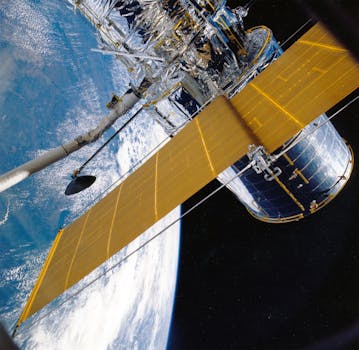The Rise of Mega-Constellations: Latest Updates in Satellite Telecommunications
The rise of mega-constellations is revolutionizing satellite telecommunications, with thousands of satellites being launched into orbit to provide global internet coverage. This article explores the latest updates in this field, including the benefits, challenges, and future prospects.

The Rise of Mega-Constellations: Latest Updates in Satellite Telecommunications
The Focus Keyword Mega-Constellations is becoming increasingly important in the field of satellite telecommunications. The rise of mega-constellations is revolutionizing the way we communicate, with thousands of satellites being launched into orbit to provide global internet coverage. This new era of space technology has the potential to bridge the digital divide, provide connectivity to remote areas, and offer a range of services such as navigation, earth observation, and communication.
What are Mega-Constellations?
Mega-constellations refer to a large group of satellites that operate together to provide a specific service. These constellations typically consist of thousands of small satellites that are launched into low Earth orbit (LEO) and work together to provide global coverage. The idea behind mega-constellations is to create a network of satellites that can provide continuous coverage of the Earth, allowing for real-time communication, navigation, and other services.
Benefits of Mega-Constellations
The benefits of mega-constellations are numerous. One of the main advantages is the ability to provide global internet coverage, which can help to bridge the digital divide and provide connectivity to remote areas. Mega-constellations can also offer a range of services such as navigation, earth observation, and communication, which can be used for a variety of applications such as aviation, maritime, and emergency response. Additionally, mega-constellations can provide a backup for traditional communication systems in the event of a disaster or outage.
Challenges and Future Prospects
Despite the many benefits of mega-constellations, there are also several challenges that need to be addressed. One of the main concerns is the risk of space debris, which can pose a hazard to other satellites and spacecraft. There is also the issue of regulatory frameworks, which need to be put in place to govern the use of mega-constellations. Furthermore, the cost of launching and maintaining a large constellation of satellites can be prohibitively expensive, which can limit access to this technology. However, as the technology continues to evolve, we can expect to see significant improvements in the efficiency and cost-effectiveness of mega-constellations.
Current Developments and Applications
Several companies, including SpaceX, OneWeb, and Amazon, are currently developing mega-constellations. SpaceX, for example, has launched over 1,000 satellites as part of its Starlink constellation, which aims to provide global internet coverage. OneWeb has also launched several satellites as part of its constellation, which will provide internet connectivity to remote areas. Amazon is also developing a mega-constellation called Kuiper Systems, which will provide broadband internet services to underserved communities. These developments demonstrate the potential of mega-constellations to transform the way we communicate and access information.


